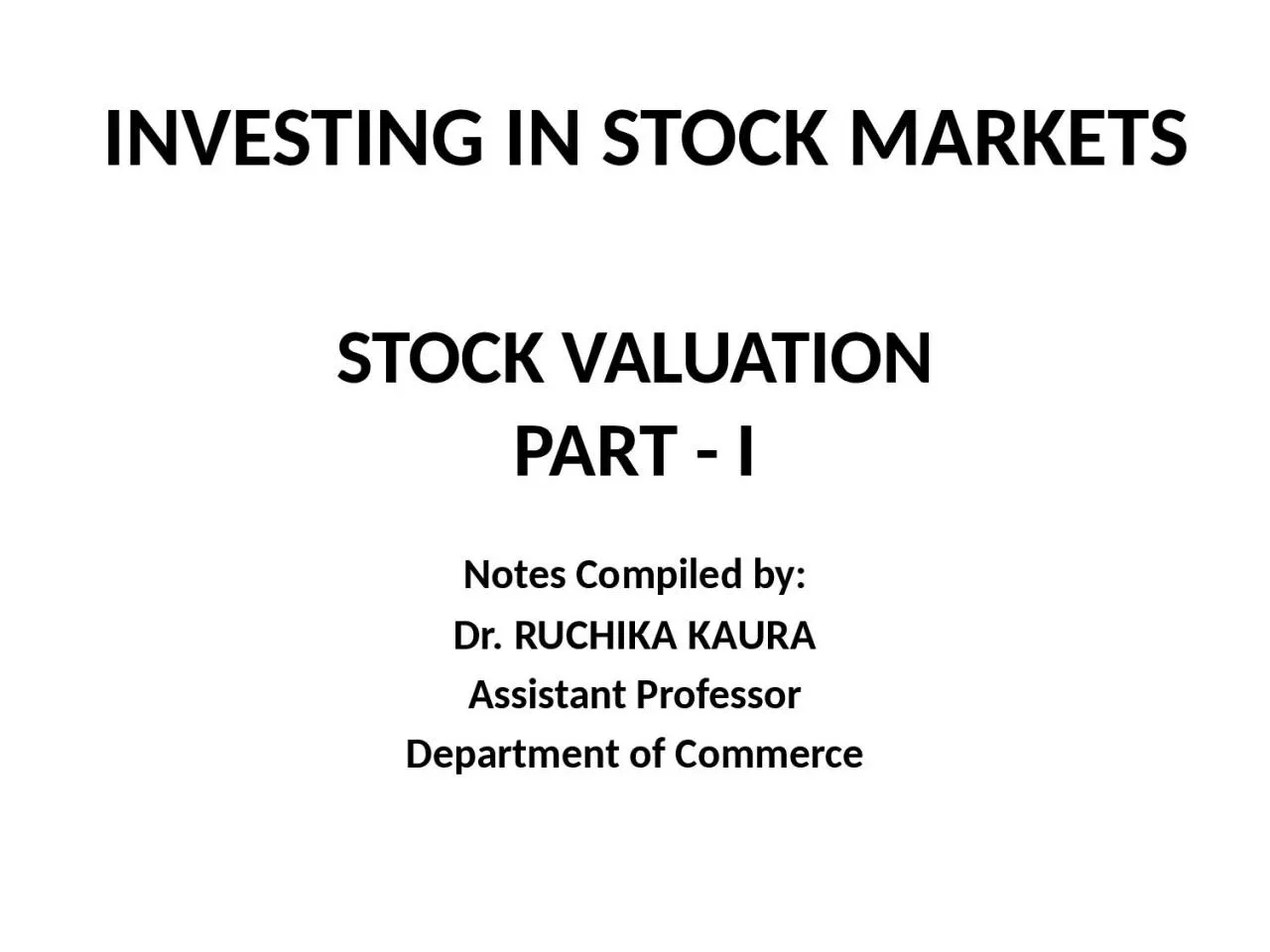

Notes Compiled by Dr RUCHIKA KAURA Assistant Professor Department of Commerce INVESTING IN STOCK MARKETS Important Questions What do you mean by valuation of stock What are the objectives of stock valuation ID: 934778
Download Presentation The PPT/PDF document "STOCK VALUATION PART - I" is the property of its rightful owner. Permission is granted to download and print the materials on this web site for personal, non-commercial use only, and to display it on your personal computer provided you do not modify the materials and that you retain all copyright notices contained in the materials. By downloading content from our website, you accept the terms of this agreement.
Slide1
STOCK VALUATIONPART - I
Notes Compiled by:Dr. RUCHIKA KAURAAssistant ProfessorDepartment of Commerce
INVESTING IN STOCK MARKETS
Slide2Important Questions
What do you mean by ‘valuation of stock’? What are the objectives of stock valuation?What do you mean by ‘valuation of stock’? Discuss the main approaches used to calculate the intrinsic value of shares.Discuss briefly the fundamental analysis approach for valuation of stock.
What is Price Earning ratio? How is this ratio different from PEG ratio?
Slide3Valuation of Stock - Meaning
Valuation of stock means to calculate the fair market value or intrinsic value of stock by using some technique or model.This fair value or intrinsic value of the share is compared with its
market price or traded price
.
If Intrinsic value < market price, it means share is
overpriced
.
If Intrinsic value > market price, it means share is
underpriced
.
Investments should not be made in overpriced shares.
An investor should
buy underpriced shares and sell overpriced shares
.
Slide4Objectives of Valuation of Stock
Most important objective is to calculate the intrinsic/fair value of the share/stock. So that the investor can compare it with its market price and decide whether to invest in these shares or not.Second objective is to make prediction of the future movement of price behaviour of shares
. So that the investor can know whether the stock is worth investing/holding or not.
Slide5Approaches to Valuation of Stock
There are basically two main approaches/ school of thoughts to valuation of stock or to calculate the intrinsic value of shares:Fundamental Analysis Approach
Technical Analysis Approach
(will be covered in next lecture)
Slide6Fundamental Analysis Approach
Under this approach, valuation of stock is done on the basis of the fundamental factors related to a company like revenue, dividends, risk, earning capacity of company etc.Intrinsic value of share is calculated using various methods/techniques devised
on the basis of any of these fundamental factors related to company/share.
Such analysis is done to help the investor in taking investment decision.
Slide7Fundamental Analysis Approach
Slide8Dividend Based Model
This model uses dividend paid by the company as the fundamental factor for stock valuation. Stock value can be computed using any of the following three formulas, depending upon whether the dividend paid by the company has no growth, constant growth or varying growth rate.
Zero Growth model:
When the company pays same amount of rupee dividend every year, the intrinsic value of share can be calculated as:
P
0
=(D
1
/
K
e
)
where P
0
= Current market price of share
D
1
= Dividend to be paid by the company at the end of the year
K
e
= Cost of equity/Equity capitalization rate
Slide9Dividend Based Model
Constant Growth model: When the dividend paid by the company grows annually at a constant rate, denoted as ‘g’, the intrinsic value of share is calculated as:P
0
=(D
1
/
K
e
- g)
where P
0
= Current market price of share
D
1
= Dividend to be paid by the company at the end of the year
K
e
= Cost of equity/Equity capitalization rate
g = Constant
rowth
rate in dividend
Slide10Earning Based Model
This model uses earning capacity of the company as the fundamental factor for stock valuation. Price Earning Ratio (P/E Ratio): P/E Ratio =
This ratio indicates the relative value of a company’s share in the stock market.
A high P/E ratio implies that the market is optimistic about the growth of the company and a low P/E ratio implies that the market is pessimistic about the growth of the company.
For
eg
. A company’s share is currently traded at Rs. 120 and its EPS is Rs. 12. So, P/E ratio = 120/12 = 10. It means that for every one rupee of earning per share, the investor will have to pay ten rupees i.e. the share is traded at a multiple of 10.
Slide11Earning Based Model
Price Earning to Growth Ratio (PEG Ratio): PEG ratio =
This is the ratio of P/E to the expected growth rate of the company.
This ratio is considered better than P/E ratio as it also considers company’s growth rate and so, gives a complete picture.
If PEG ratio is less than 100%, it is considered as desirable because it shows that the stock is undervalued, so, can be purchased for investment.
If PEG ratio is more than 100%, it is considered as undesirable because it shows that the stock is overvalued, so, should not be considered for investment.
Slide12Revenue Based Model
Price Revenue Ratio (P/R ratio): P/R ratio = or P/R ratio =
(market capitalization= market price per share * no. of equity shares)
This ratio measures the value of a company’s share for every rupee of sales/revenues made by the company.
Many investors consider this ratio as better than the P/E or PEG ratios because it considers revenues earned or sales made by the company instead of the earnings of the company as earnings are influenced by so many factors such as the management manipulations, accounting policies etc.
Slide13References
Investing in stock markets by Dr. R.S. Bhardwaj and Bhamini GargInvesting in stock markets by Prof. (Dr.)
Vanita
Tripathi
and
Neeti
Panwar
Read these links from the net:
https://www.thebalance.com/tools-of-fundamental-analysis-3140772
https://www.taxmann.com/bookstore/bookshop/bookfiles/Investing%20in%20Stock%20MarketsVanita%20Tripathichapter4.pdf